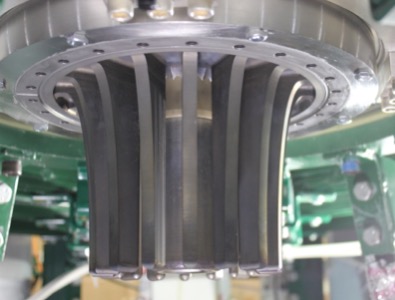UC San Diego Center for Energy Research, LPPFusion to Collaborate on Fusion Energy Research
October 5, 2017
|
Electrodes at LPPFusion's FF-1 device are only 10 inches across. Photo courtesy of LLPFusion, Inc. |
An energy source that is safe, clean, inexhaustible, cheaper than any available today and that can be delivered by small, decentralized units would change the world. Fossil fuel pollution and costs could be eliminated and communities made secure against the simultaneous collapse of electricity and fuel-supply networks, as has happened in Puerto Rico and elsewhere.
That ideal energy source is the goal of a new collaboration between the Center for Energy Research (CER) at UC San Diego and LPPFusion, Inc., a private company in Middlesex, NJ. The collaboration, formalized with an agreement on October 2, aims at the development of the dense plasma focus (DPF) device for fusion energy. "The alternate fusion schemes offer a potential route to fusion energy that could be faster and much cheaper than other approaches," explains CER Director, Farhat N. Beg. "LPPFusion is a leader in this field and will make available to CER its research data and expertise to help us set up our own DPF facility at UC San Diego."
LPPFusion’s FF-1 device is one of only a few mega-ampere DPFs in the world. Their research in the coming year will involve the first experiments using hydrogen-boron fuel. This fuel produces energy in the form of charged particles only, not neutrons, which both eliminates radioactive waste and makes possible inexpensive direct conversion of energy to electricity. The company terms the combination of DPF with hydrogen boron fuel “Focus Fusion”.
While the DPF is capable of briefly achieving temperatures higher than at the center of the sun, it is a small device that is only a dozen feet on a side, with central electrodes only inches across. Even a powerful DPF like FF-1 can be built for around half a million dollars, in contrast to almost all other fusion energy devices.
|

Electrodes undergoing microwave cleaning. Photo courtesy of LLPFusion, Inc. |
"The collaboration with the Center for Energy Research will help us to better analyze and understand our data," said LPPFusion President and Chief Scientist Eric J. Lerner. “Their expertise in plasma simulation will aid our efforts in modeling our experiments. We also expect that, once their own DPF is functioning, we can perform joint experiments that will help demonstrate how the DPF energy output scales with energy input. That is crucial to achieving the goal of getting more energy out of the device than we put into it.”
LPPFusion is already collaborating with two DPF efforts in Poland, one at the Institute of Nuclear Physics of the Polish Academy of Sciences in Krakow and the other at the Institute of Plasma Physics and Laser Microfusion in Warsaw. For the Center for Energy Research, the LPPFusion collaboration will add a new approach to the fusion collaborations the Center already has with other leading fusion labs, including JET, the world’s largest tokamak in Culham, England and Princeton Plasma Physics Laboratory.

